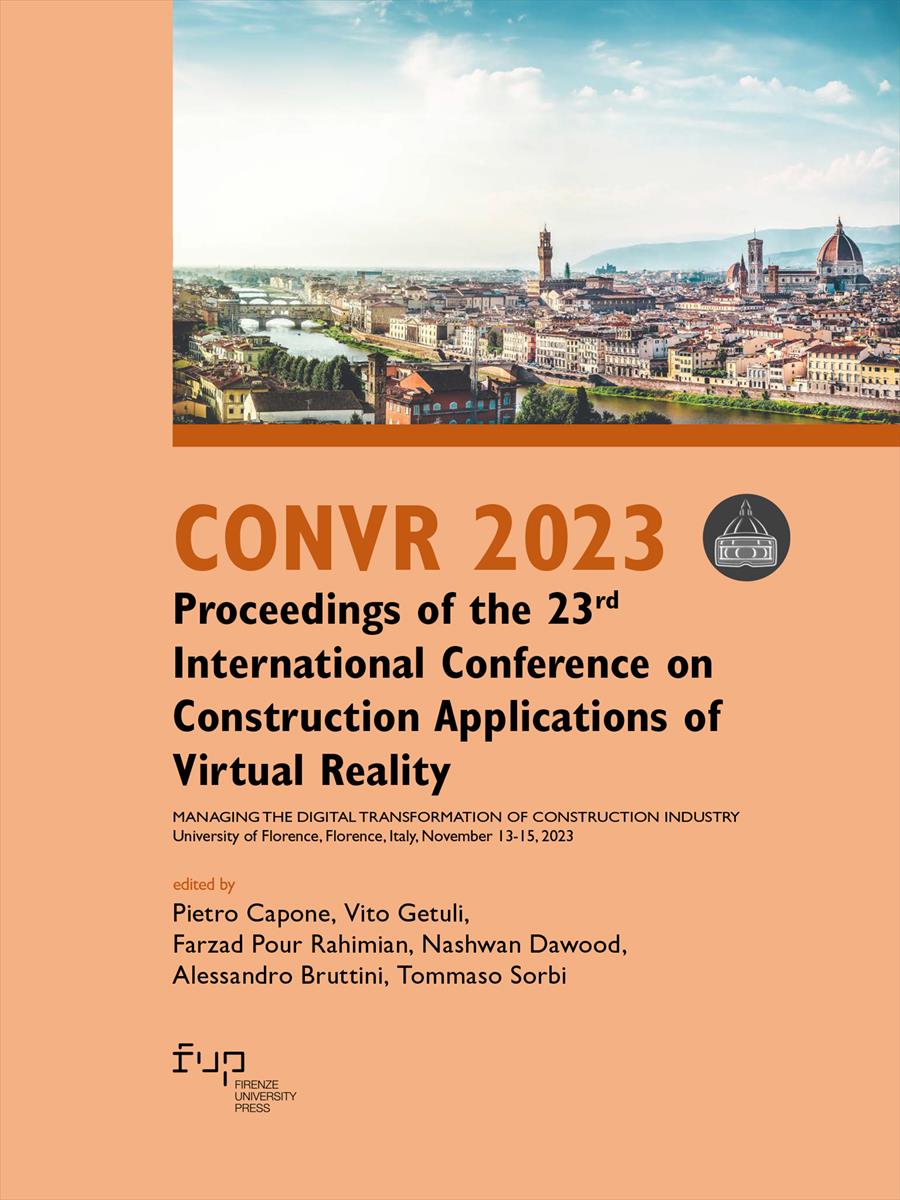- CONVR 2023 - Proceedings of the 23rd International Conference on Construction Applications of Virtual Reality
- A cura di Pietro Capone, Vito Getuli, Farzad Pour Rahimian, Nashwan Dawood, Alessandro Bruttini, Tommaso Sorbi
Optimal Number of Cue Objects for Photo-Based Indoor Localization
- Youngsun Chung
- Daeyoung Gil
- Ghang Lee
- © 2023 Author(s) |
- CC BY-NC 4.0
- DOI: 10.36253/979-12-215-0289-3.98
Building information modeling (BIM) is widely used to generate indoor images for indoor localization. However, changes in camera angles and indoor conditions mean that photos are much more changeable than BIM images. This makes any attempt at localization based on the similarity between real photos and BIM images challenging. To overcome this limitation, we propose a reasoning-based approach for determining the location of a photo by detecting the cue objects in the photo and the relationships between them. The aim of this preliminary study was to determine the optimal number of cue objects required for an indoor image. If there are too few cue objects in an indoor image, it results in an excessive number of location candidates. Conversely, if there are too many cue objects, the accuracy of object detection in an image decreases. Theoretically, a larger number of cue objects would improve the reasoning process; however, too many cue objects could lead to declining object detection performance. The experimental results demonstrated that of two to five cue objects, three cue objects is most likely to yield optimal performance
- Keywords:
- indoor location determination,
- BIM,
- reasoning,
Yonsei University, Korea (the Republic of)
Yonsei University, Korea (the Republic of) - ORCID: 0000-0001-9845-6687
Yonsei University, Korea (the Republic of) - ORCID: 0000-0002-3522-2733
- Acharya, D., Khoshelham, K., & Winter, S. (2019). BIM-PoseNet: Indoor camera localisation using a 3D indoor model and deep learning from synthetic images. ISPRS Journal of Photogrammetry and Remote Sensing, 150, 245–258. DOI: 10.1016/j.isprsjprs.2019.02.020
- Acharya, D., Roy, S., Khoshelham, K., & Winter, S. (2020). A recurrent deep network for estimating the pose of real indoor images from synthetic image sequences. Sensors, 20(19), 1–20. DOI: 10.3390/s20195492
- Alam, M., Hossain, A. K. M., & Mohamed, F. (2022). Performance evaluation of recurrent neural networks applied to indoor camera localization. International Journal of Emerging Technology and Advanced Engineering, 12(8), 116–124. DOI: 10.46338/ijetae0822_15
- Bay, H., Tuytelaars, T., & Van Gool, L. (2006). SURF: Speeded up robust features. In A. Leonardis, H. Bischof, & A. Pinz (Eds.), Computer Vision – ECCV 2006 (pp. 404–417). Springer. DOI: 10.1007/11744023_32
- Guan, K., Ma, L., Tan, X., & Guo, S. (2016). Vision-based indoor localization approach based on SURF and landmark. 2016 International Wireless Communications and Mobile Computing Conference (IWCMC), (pp. 655–659). DOI: 10.1109/IWCMC.2016.7577134
- Ha, I., Kim, H., Park, S., & Kim, H. (2018). Image retrieval using BIM and features from a pretrained VGG network for indoor localization. Building and Environment, 140, 23–31. DOI: 10.1016/j.buildenv.2018.05.026
- Kang, H., Park, Y., & Kim, Y. (2019). Improvement model of defect information management system for apartment buildings. Korean Journal of Construction Engineering and Management, 20(4), 13–21. DOI: 10.6106/KJCEM.2019.20.4.013
- Kim, D., & Kim, J. (2023). CT-Loc: Cross-domain visual localization with a channel-wise transformer. Neural Networks, 158, 369–383. DOI: 10.1016/j.neunet.2022.11.014
- Kim, J. (2022). Identifying indoor locations of close-up photos using deep learning and building information modeling objects. Yonsei University. http://www.riss.kr/link?id=T16372630
- Kim, K.-T., Lim, M.-G., & Kim, G.-T. (2014). History management technology of building construction and maintenance using vector photo information and BIM. Journal of the Korea Institute of Building Construction, 14(6), 605–613. DOI: 10.5345/JKIBC.2014.14.6.605
- Li, Y., Kambhamettu, R. H., Hu, Y., & Zhang, R. (2022). ImPos: An image-based indoor positioning system. 2022 IEEE 19th Annual Consumer Communications & Networking Conference (CCNC), (pp. 144–150). DOI: 10.1109/CCNC49033.2022.9700699
- Redmon, J., Divvala, S., Girshick, R., & Farhadi, A. (2016). You only look once: Unified, real-time object detection. Computer Vision and Pattern Recognition Conference (CVPR), (pp. 779-788). https://openaccess.thecvf.com/content_cvpr_2016/html/Redmon_You_Only_Look_CVPR_2016_paper.html
- Simonyan, K., & Zisserman, A. (2015). Very deep convolutional networks for large-scale image recognition. arXiv. DOI: 10.48550/arXiv.1409.1556
Informazioni sul capitolo
Titolo del capitolo
Optimal Number of Cue Objects for Photo-Based Indoor Localization
Autori
Youngsun Chung, Daeyoung Gil, Ghang Lee
DOI
10.36253/979-12-215-0289-3.98
Opera sottoposta a peer review
Anno di pubblicazione
2023
Copyright
© 2023 Author(s)
Licenza d'uso
Licenza dei metadati
Informazioni bibliografiche
Titolo del libro
CONVR 2023 - Proceedings of the 23rd International Conference on Construction Applications of Virtual Reality
Sottotitolo del libro
Managing the Digital Transformation of Construction Industry
Curatori
Pietro Capone, Vito Getuli, Farzad Pour Rahimian, Nashwan Dawood, Alessandro Bruttini, Tommaso Sorbi
Opera sottoposta a peer review
Anno di pubblicazione
2023
Copyright
© 2023 Author(s)
Licenza d'uso
Licenza dei metadati
Editore
Firenze University Press
DOI
10.36253/979-12-215-0289-3
eISBN (pdf)
979-12-215-0289-3
eISBN (xml)
979-12-215-0257-2
Collana
Proceedings e report
ISSN della collana
2704-601X
e-ISSN della collana
2704-5846
